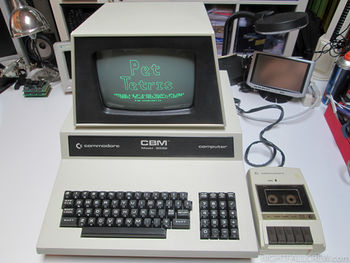Repair PET2001 AKA CMB 3032: Difference between revisions
No edit summary |
|||
| Line 15: | Line 15: | ||
[[File:IMG 2403.JPG|800px]] | [[File:IMG 2403.JPG|800px]] | ||
I have both the later 80-column machine (the 8032) and the original 40-column machine the CBM 3032, the first one works but not the latter one, which sucks as all the good software was written for the 40-column machine, so I'm trying to repair | I have both the later 80-column machine (the 8032) and the original 40-column machine the CBM 3032, the first one works but not the latter one, which sucks as all the good software was written for the 40-column machine, so I'm trying to repair the defective 40-column PET. | ||
== repair at Revspace started 11 July 2017 == | == repair at Revspace started 11 July 2017 == | ||
Revision as of 00:28, 19 July 2017
| Project repair PET2001 (AKA CBM2032) | |
|---|---|

| |
| Een poging tot reparatie van een echte klassieker, de CBM 3032 uit 1977 | |
| Status | In progress |
| Contact | Mahjongg |
| Last Update | 2017-07-19 |
The original first PET, for Personal Electronic Transactor (The "Blue label PET" variant with calculator keys, and a built in tapedeck) was one of the "Trinity", The three first commercial, microprocessor based, "home computers" which were released in 1977 almost simultaneously. They started the microcomputer (personal computer) revolution, and the trinity was the PET 2001 from Commodore, the TRS-80 model 1 from Tandy corporation, and the Apple ][ from Apple computers.
Soon after that launch, Commodore realised they had a winner, and when they had depleted their small supply of surplus calculator keys they used for their launch machines (they were in the calculator business, but had lost out to Texas Instruments) they realised a better keyboard was needed, so they removed the built in tapedeck to make room for one, and released this improved version as the "Commodore Business Machine" or CBM in three types, one with 8K RAM, one with 16K RAM and one with 32K RAM, this last one was called the type 3032, where the 32 stood for the amount of 32K RAM The 8K and 16K machines proved to be less popular, and really only were bought by people who tried to convert them to 32K machines themselves, a practice Commodore actively tried to make impossible by drilling large holes in the place on the board where the second 16K RAM bank was located! See Picture below, where you can see the four large holes drilled in a row though the unused second bank of ram chips in the front of the large PCB:
I have both the later 80-column machine (the 8032) and the original 40-column machine the CBM 3032, the first one works but not the latter one, which sucks as all the good software was written for the 40-column machine, so I'm trying to repair the defective 40-column PET.
repair at Revspace started 11 July 2017
The symptoms are that the system when turned on gives an inverted (all white) picture with only a black blinking cursor, and the picture is very unstable, as if there are large amounts of ripple in the power supply, and it also disappears unless you tap the enclosure. So I had already replaced the massive 23000 MFD (microfarad) 15V DC "Bulk Elco" with screw terminals tie-rapped to the bottom of the case, and a slightly smaller 4700uF 25V axial elco on the main board, but without any change, So probably one of the elco's in the monitor itself has gone bad, I have now removed the monitor (head part) from the PET, and removed another elco from its PCB, next time I will bring a replacement elco, and a new fuse (large size 3/4A 250V slow blow) which I blew due to me stupidly shorting the 18V AC leads leading the the monitor from the very bulky transformer. I will also clean the brightness potentiometer as I think its causing the disappearance of the video due to a bad contact in it.
further repair on monitor 19 July 2017
I removed, cleaned and tested the 100K brightness potmeter, and it was fine, no intermittent contacts. Even though I noted that putting pressure an its axis brought back the picture, but I suspected a cold joint somewhere on the PCB, so I resoldered any and all solder joints, and in the end managed to get a stable picture out of the scope, that didn't disappear all the time, but was still shaky. I noted that after a minute or so I saw black stripes in the white picture, and it seemed to become worse as time passed, I had seem this the very first time I turned on the PET too, but now the monitor stayed on it was more obvious. To me it looked like a bad chip somewhere that failed as it was warming up. I decided to do some voltage checking, and to my horror found about 7.5V on first one, and then other LSTTL chips in the from of the board. So there is a power supply fault somewhere, which may explain why when turning the PET off I see a glimpse of the *** COMMODORE BASIC *** initialisation text Perhaps that during the falling of the power voltage, for a moment the display logic starts working.... I don't know if (LS) TTL can withstand 7.5V for very long, but perhaps I'm lucky. I think the PET has two different 5V "zones" each one powered by a different 5V regulator. Perhaps the fault is only in the display logic "zone", and not in the CPU logic "zone". I have to printout the schematic (which I have in electronic form) to check this, then attempt to use a bench power supply to power the display zone. I noticed that the -5V supply voltage was okay.
